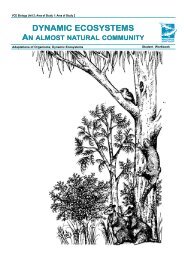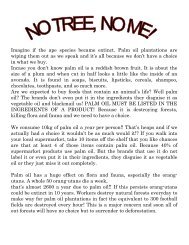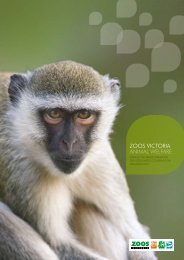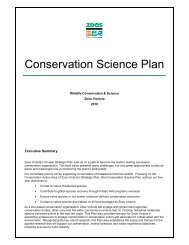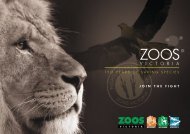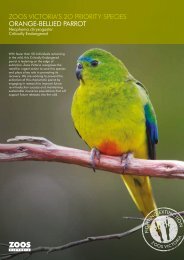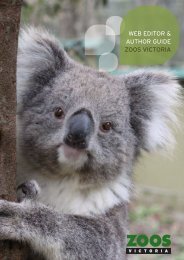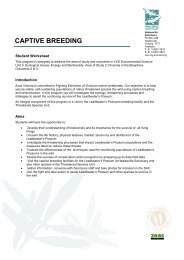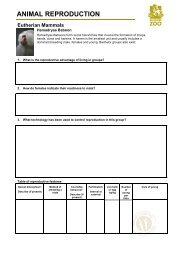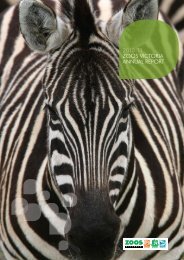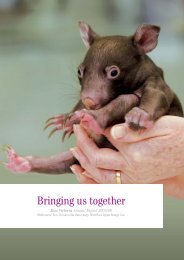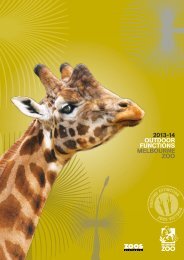Fighting Extinction - Zoos Victoria
Fighting Extinction - Zoos Victoria
Fighting Extinction - Zoos Victoria
You also want an ePaper? Increase the reach of your titles
YUMPU automatically turns print PDFs into web optimized ePapers that Google loves.
Contributions<br />
The application of <strong>Zoos</strong> <strong>Victoria</strong>’s ‘<strong>Fighting</strong> <strong>Extinction</strong>’ commitment<br />
to the conservation of Leadbeater’s Possum Gymnobelideus leadbeateri<br />
Dan Harley<br />
Wildlife Conservation and Science Department, <strong>Zoos</strong> <strong>Victoria</strong><br />
Email: dharley@zoo.org.au<br />
Abstract<br />
As part of its ‘<strong>Fighting</strong> <strong>Extinction</strong>’ program, <strong>Zoos</strong> <strong>Victoria</strong> has developed criteria to guide when it will initiate<br />
captive-breeding programs for native threatened species. Application of these criteria, which are based on<br />
extinction risk, has resulted in the identification of twenty priority threatened species for ex situ conservation.<br />
This list includes the genetically-distinct lowland population of Leadbeater’s Possum. As a result, a captivebreeding<br />
program has been initiated to prevent the extinction of this population. The ‘<strong>Fighting</strong> <strong>Extinction</strong>’<br />
strategy represents a more structured, systematic and integrated approach to how <strong>Zoos</strong> <strong>Victoria</strong> is attempting<br />
to deliver tangible conservation outcomes. Notably, measures of success are tied to the condition of wild populations.<br />
Aspects of the ‘<strong>Fighting</strong> <strong>Extinction</strong>’ strategy and the Leadbeater’s Possum captive-breeding program<br />
are described. (The <strong>Victoria</strong>n Naturalist 129 (5) 2012, 175-180)<br />
Keywords: Leadbeater’s Possum; captive-breeding; zoo; threatened species; extinction<br />
In its 20-year strategic plan, <strong>Zoos</strong> <strong>Victoria</strong> has<br />
committed to transforming itself into a ‘zoobased<br />
conservation organisation’ that delivers<br />
tangible conservation outcomes for wildlife<br />
populations. Considerable effort has gone into<br />
defining precisely what this means, and the<br />
strategy highlights that the organisation is not<br />
just concerned with the captive collection, but<br />
is very much focused on the condition of wild<br />
populations. In terms of delivering tangible outcomes,<br />
the conservation of native threatened<br />
species has been identified as a clear priority,<br />
and forms one of the central elements to a more<br />
holistic conservation approach that has been<br />
developed under the banner ‘<strong>Fighting</strong> <strong>Extinction</strong>’.<br />
Part of this approach is outlined below.<br />
‘<strong>Fighting</strong> <strong>Extinction</strong>’<br />
To create greater transparency around when<br />
we will initiate captive-breeding programs for<br />
native threatened species, the following commitment<br />
has been made:<br />
‘<strong>Zoos</strong> <strong>Victoria</strong> will ensure that no <strong>Victoria</strong>n<br />
species of terrestrial vertebrate become extinct.’<br />
The focus on terrestrial vertebrates reflects<br />
the expertise at <strong>Zoos</strong> <strong>Victoria</strong>’s three properties,<br />
Melbourne Zoo, Werribee Open Range Zoo<br />
and Healesville Sanctuary.<br />
In applying this criterion, <strong>Victoria</strong>n species<br />
have been assessed and prioritized based on<br />
their likelihood of extinction in the wild over the<br />
next 10 years. These qualitative determinations<br />
Vol 129 (5) 2012<br />
focused on population size and trend, extent<br />
of distribution and key threatening processes.<br />
In addition to the eleven captive-breeding programs<br />
that <strong>Zoos</strong> <strong>Victoria</strong> already had in place<br />
for species occurring in south-eastern Australia<br />
(seven of which targeted <strong>Victoria</strong>n species; see<br />
Table 1), this review identified nine additional<br />
<strong>Victoria</strong>n species warranting ex situ recovery<br />
measures (Table 2), including Leadbeater’s<br />
Possum Gymnobelideus leadbeateri. Hence,<br />
<strong>Zoos</strong> <strong>Victoria</strong> has arrived at a priority list of<br />
20 native threatened species. This list will be<br />
reviewed periodically, and species added or<br />
removed as new data become available and/<br />
or circumstances in the wild change. Note that<br />
under these criteria, ex situ intervention is not<br />
triggered for species that are in decline within<br />
<strong>Victoria</strong> but have strongholds in other States or<br />
Territories.<br />
Having a clear understanding of why we are<br />
focused on certain species and not others has<br />
created greater clarity in where <strong>Zoos</strong> <strong>Victoria</strong><br />
invests resources. New captive programs have<br />
already been initiated for four of the nine species<br />
listed in Table 2. For these additional species,<br />
our approach first involves the establishment<br />
of captive populations, followed by subsequent<br />
releases to the wild to recover populations.<br />
Three of <strong>Victoria</strong>’s highest profile threatened<br />
species highlight the important role that zoos<br />
can play in conservation. The mainland Eastern<br />
Barred Bandicoot Perameles gunnii unnamed<br />
175
Contributions<br />
Table 1. The 11 native threatened species included in <strong>Zoos</strong> <strong>Victoria</strong>’s captive-breeding programs prior to 2011.<br />
Common Scientific Conservation Year Captive Reintro-<br />
Name Name Status commenced breeding duction<br />
(EPBC Act)<br />
Tasmanian Devil Sarcophilus Endangered 2006 <br />
harrisii<br />
Mountain Pygmy Burramys parvus Endangered 2007 <br />
Possum<br />
Eastern Barred Perameles gunnii Endangered 1990 <br />
Bandicoot (mainland) unnamed subspp.<br />
Orange-bellied Parrot Neophema Critically 1991 <br />
chrysogaster Endangered<br />
Helmeted Lichenostomus Endangered 1989 <br />
Honeyeater<br />
melanops cassidix<br />
Regent Anthochaera Endangered 2002 <br />
Honeyeater<br />
phrygia<br />
Spotted Tree Frog Litoria spenceri Endangered 2006 <br />
Southern Barred Frog Mixophyes balbus Vulnerable 2001 <br />
Southern Pseudophryne Endangered 2008 <br />
Corroboree Frog corroboree<br />
Northern Pseudophryne Vulnerable 2010 <br />
Corroboree Frog pengilleyi<br />
Lord Howe Island Dryococelus Critically 2003 <br />
Stick Insect australis Endangered<br />
Table 2. The nine additional <strong>Victoria</strong>n threatened species identified as warranting ex situ intervention under<br />
<strong>Zoos</strong> <strong>Victoria</strong>’s ‘<strong>Fighting</strong> <strong>Extinction</strong>’ commitment.<br />
Common Name Scientific Name Conservation<br />
Status (EPBC Act)<br />
Leadbeater’s Possum (Yellingbo ESU) Gymnobelideus leadbeateri Endangered<br />
Brush-tailed Rock-wallaby (Southern ESU) Petrogale penicillata Vulnerable<br />
Smoky Mouse Pseudomys fumeus Endangered<br />
New Holland Mouse Pseudomys novaehollandiae Vulnerable<br />
Southern Bent-wing Bat Miniopterus schreibersii bassanii Critically Endangered<br />
Grassland Earless Dragon Tympanocryptis pinguicolla Endangered<br />
Alpine She-oak Skink Cyclodomorphus praealtus Endangered<br />
Guthega Skink Liopholis guthega Endangered<br />
Baw Baw Frog Philoria frosti Endangered<br />
subspp. would be extinct if it were not for the<br />
breeding and release program undertaken by<br />
Melbourne Zoo. Similarly the Helmeted Honeyeater<br />
Lichenostomus melanops cassidix may<br />
be extinct if it were not for the breeding and<br />
release program undertaken by Healesville<br />
Sanctuary. And the Orange-bellied Parrot Neophema<br />
chrysogaster is predicted to go extinct<br />
in the wild during the next five years; however<br />
a large insurance population has been established<br />
in captivity. All the recovery potential<br />
for these <strong>Victoria</strong>n species rests on successful<br />
captive-breeding and release programs. Conversely,<br />
each of these breeding programs has<br />
been in place for about 20 years and yet wild<br />
populations for each species remain at risk.<br />
Thus, some adjustments are required to the recovery<br />
models being applied.<br />
In recognition of the need to increase the effectiveness<br />
of captive-breeding and release programs,<br />
<strong>Zoos</strong> <strong>Victoria</strong> has made several changes<br />
in how it is approaching threatened species recovery.<br />
We are working with recovery teams to<br />
achieve greater clarity and integration of the re-<br />
176 The <strong>Victoria</strong>n Naturalist
Contributions<br />
covery targets for the wild and captive components<br />
to these programs. Too often in the past,<br />
the parties driving in situ and ex situ recovery<br />
measures have operated independently of one<br />
another. If the captive-breeding programs exist<br />
fundamentally to serve the wild, then ultimately<br />
they should be responsive to the recovery needs<br />
of the wild populations.<br />
In order to minimise the loss of genetic diversity<br />
in captive populations, we are looking to<br />
manage our threatened species as part of captive–wild<br />
metapopulations. This involves periodic<br />
transfer of individuals between all populations,<br />
regardless of whether they are captive<br />
or wild, to maintain gene flow. This is already<br />
being done effectively for the Helmeted Honeyeater.<br />
We also recognise that the ‘quality’ of<br />
the individuals being bred in captivity has important<br />
implications for success when we come<br />
to release to the wild. This has become a major<br />
research focus for <strong>Zoos</strong> <strong>Victoria</strong>, and includes<br />
the application of techniques to promote mate<br />
choice and the retention of appropriate wild behaviours<br />
in captive populations.<br />
Finally, the ultimate measure of success for<br />
our ‘<strong>Fighting</strong> <strong>Extinction</strong>’ programs is the condition<br />
of wild populations. Specific five-year<br />
and 20-year recovery objectives have been developed<br />
for each species in the wild and captivity,<br />
resulting in greater integration of in situ and<br />
ex situ approaches.<br />
Leadbeater’s Possum<br />
Leadbeater’s Possum is a small (110–160 g),<br />
arboreal marsupial that was thought to be extinct<br />
prior to its rediscovery near Marysville<br />
in 1961 (Wilkinson,1961). The possum is the<br />
only species of native mammal restricted in<br />
distribution entirely to <strong>Victoria</strong>, and its current<br />
range is confined to a 70 × 80 km area centred<br />
on montane habitats in the <strong>Victoria</strong>n Central<br />
Highlands (see Harley 2004). A single, remnant,<br />
outlying population occurs in lowland<br />
habitats at Yellingbo Nature Conservation Reserve<br />
(Harley et al. 2005). Molecular data have<br />
revealed that the lowland population at Yellingbo<br />
is genetically distinct from populations<br />
occupying montane habitats (Hansen 2008;<br />
Hansen and Taylor 2008; Hansen et al. 2009).<br />
Owing to its restricted distribution, small population<br />
size (< 2000 individuals) and the loss of<br />
Vol 129 (5) 2012<br />
mature, hollow-bearing trees that provide dens,<br />
the species is currently listed as ‘endangered’<br />
under the Commonwealth Environment Protection<br />
and Biodiversity Conservation Act 1999<br />
and ‘threatened’ under the <strong>Victoria</strong>n Flora and<br />
Fauna Guarantee Act 1988. Notably, the Black<br />
Saturday wildfires in 2009 burnt approximately<br />
45% of the high quality habitat for the species<br />
(S. Smith, unpubl. data), greatly elevating the<br />
extinction risk for this species.<br />
<strong>Zoos</strong> <strong>Victoria</strong> has assessed the extinction likelihood<br />
for Leadbeater’s Possum populations in<br />
montane habitats and at Yellingbo against its<br />
‘<strong>Fighting</strong> <strong>Extinction</strong>’ criteria (i.e. our trigger<br />
for captive intervention). The montane populations<br />
are in serious decline, particularly following<br />
the Black Saturday fires, and the extinction<br />
risk is very real over coming decades. However,<br />
the species is not likely to become extinct across<br />
the entire Central Highlands during the next<br />
10 years, and hence they do not yet trigger ex<br />
situ intervention. Moreover, the key challenges<br />
in the Central Highlands are related to habitat<br />
conditions, and captive-breeding is not an appropriate<br />
tool to address this problem.<br />
In contrast, the small, genetically-distinct<br />
lowland population at Yellingbo does meet<br />
<strong>Zoos</strong> <strong>Victoria</strong>’s criteria for ex situ intervention,<br />
as a single fire could eliminate the entire population<br />
given its localized occurrence. Hence,<br />
this population is the focus of <strong>Zoos</strong> <strong>Victoria</strong>’s<br />
captive-breeding and release program.<br />
Population monitoring for the lowland Leadbeater’s<br />
Possums at Yellingbo has been underway<br />
for 17 years (Harley 2005; Harley and<br />
Antrobus unpubl. data). Data describing the<br />
species’ population dynamics at this site is the<br />
best available for any <strong>Victoria</strong>n mammal (given<br />
it is a closed population and more than 90% of<br />
the total population is sampled every year). The<br />
annual monitoring program results in several<br />
measures of population condition, including<br />
total population size, distribution, territory<br />
stability, mean colony size, reproductive rate,<br />
annual recruitment and dispersal. The current<br />
size of the population is approximately 60<br />
individuals, and it has declined by 46% during<br />
the past nine years (Harley and Antrobus,<br />
unpubl. data). Changes in the genetic characteristics<br />
of the population over the past 10 years<br />
are currently being assessed. The key threat to<br />
177
Contributions<br />
this population is the serious decline in habitat<br />
conditions in the reserve, and as a consequence<br />
the availability of suitable foraging habitat has<br />
become the key limiting factor (Harley et al.<br />
2005; Harley, unpubl. data).<br />
<strong>Zoos</strong> <strong>Victoria</strong> has developed five-year and 20-<br />
year objectives for the recovery of Leadbeater’s<br />
Possum in lowland habitats (covering both wild<br />
and captive populations). The five-year objectives<br />
developed for the wild emphasise the<br />
need to address habitat decline at Yellingbo, the<br />
key threatening process at this site. To achieve<br />
this, <strong>Zoos</strong> <strong>Victoria</strong> needs to work with partners<br />
such as Parks <strong>Victoria</strong>, highlighting the importance<br />
of integrating in situ and ex situ recovery<br />
measures.<br />
In captivity, the five-year objectives are as<br />
follows:<br />
1. Healesville Sanctuary and Melbourne Zoo<br />
house a viable captive insurance population<br />
comprising at least 20 individuals for the<br />
genetically-distinct lowland population of<br />
Leadbeater’s Possum at Yellingbo.<br />
2. Captive possums are managed to promote<br />
successful breeding and maintain wild behaviours.<br />
3. Release techniques are developed to successfully<br />
establish captive-bred individuals in the<br />
wild.<br />
4. <strong>Zoos</strong> <strong>Victoria</strong> provides unique opportunities<br />
for the public to engage with Leadbeater’s<br />
Possum and its conservation.<br />
The first four founders for the captive<br />
population were collected during May 2012<br />
and are now housed at Healesville Sanctuary.<br />
The collection schedule for founders is four<br />
possums per year for three years. Collection<br />
has been staggered over time to minimise<br />
any negative impact on the wild population.<br />
Individuals are being selected based on their<br />
genetic attributes and to avoid disrupting<br />
colony structure (e.g. collection of dispersalage<br />
subadults). The target size of the insurance<br />
population is 20–30 individuals, and this will<br />
be spread across two properties, Healesville<br />
Sanctuary and Melbourne Zoo. We intend<br />
to manage the insurance population as part<br />
of a captive–wild metapopulation, albeit this<br />
requires us to be able to successfully establish<br />
captive-bred young in the wild.<br />
We are placing considerable emphasis on trying<br />
to maintain key wild behaviours in the captive<br />
possums, and this is being reflected in the<br />
types of animal monitoring we are undertaking<br />
(e.g. filming visitation to food stations and activity<br />
periods). We are using the behaviour exhibited<br />
by the wild-caught founders as a benchmark<br />
against which we can assess captive-bred<br />
young in future years.<br />
Our ultimate goal is recovery of wild populations<br />
of Leadbeater’s Possum in lowland habitats.<br />
The 20-year objectives for the wild define<br />
our vision of success, and are as follows:<br />
1. Wild population size at Yellingbo exceeds<br />
150 individuals.<br />
2. Greater than 25% of the Cockatoo and Macclesfield<br />
Creek floodplains provide high<br />
quality habitat for Leadbeater’s Possums.<br />
3. Population and habitat monitoring programs<br />
maintained for Leadbeater’s Possum at Yellingbo.<br />
4. Establishment of at least one additional lowland<br />
population containing a minimum of 50<br />
individuals.<br />
Note that these objectives list a minimum<br />
population size for Yellingbo (≥150 individuals)<br />
that should be self-sustaining in terms of population<br />
processes. They also specify the area of<br />
habitat required to achieve this population target,<br />
and identify the need to establish additional<br />
lowland populations away from Yellingbo. The<br />
latter point highlights that success with this species<br />
ultimately means that we would no longer<br />
require an insurance population in captivity.<br />
There are two key reasons why <strong>Zoos</strong> <strong>Victoria</strong><br />
has directed its conservation efforts at the<br />
Yellingbo population of Leadbeater’s Possum:<br />
(i) this population is at the greatest risk of<br />
extinction in the short-term (i.e. within 10<br />
years), and (ii) the population is genetically<br />
distinct. In 2011, the Leadbeater’s Possum Recovery<br />
Team debated whether conservation of<br />
the unique lowland genes at Yellingbo is of high<br />
importance. The consensus was it is important<br />
to protect them. Moreover, conservation of genetic<br />
diversity across a species’ range is an important<br />
principle, and this has been reflected<br />
in the approach of the <strong>Victoria</strong>n Government<br />
where several high-profile threatened species<br />
recovery programs target subspecies or genetically-distinct<br />
populations (‘Evolutionarily<br />
Significant Units’), e.g. Red-tailed Black-Cock-<br />
178 The <strong>Victoria</strong>n Naturalist
Contributions<br />
atoo, Helmeted Honeyeater, Eastern Barred<br />
Bandicoot, Brush-tailed Rock-wallaby, Mountain<br />
Pygmy Possum.<br />
Action for the Yellingbo population of Leadbeater’s<br />
Possum alone is clearly insufficient to<br />
adequately conserve this species. Thh e species’<br />
stronghold is in the montane forests of the<br />
<strong>Victoria</strong>n Central Highlands, and consequently<br />
the main conservation focus from government<br />
should be directed there. Greater recovery focus<br />
on the montane populations following the<br />
Black Saturday fires is clearly warranted. In applying<br />
a holistic conservation strategy for this<br />
species (that incorporates risk-spreading), recovery<br />
models (and actions) should be articulated<br />
for all three forest types that Leadbeater’s<br />
Possum inhabits (i.e. montane ash forest, subalpine<br />
woodland and lowland swamp forest)<br />
that take account of the different threats and<br />
management issues.<br />
Community Engagement<br />
Melbourne Zoo, Werribee Open Range Zoo and<br />
Healesville Sanctuary attracted approximately<br />
1.9 million visitors in 2011. A high proportion<br />
of this audience lives in urban environments,<br />
yet the majority of threatened species issues<br />
occur in regional areas. <strong>Zoos</strong> have a unique<br />
opportunity to bridge this gap, connect people<br />
with the issues and provide them with simple<br />
things they can do to assist. In recognition of<br />
this, <strong>Zoos</strong> <strong>Victoria</strong> has developed specific ‘visitor<br />
objectives’ to sit alongside our breeding and<br />
release targets. The ‘Wipe for Wildlife’ campaign<br />
at Healesville Sanctuary urging visitors to<br />
use recycled toilet paper to reduce the number<br />
of trees harvested is an example of this approach.<br />
Importantly, subsequent uptake among<br />
visitors is being measured. In association with<br />
the Leadbeater’s Possum program we are promoting<br />
the use of Forest Stewardship Council<br />
(FSC) certified timber and paper products.<br />
These programs apply the Connect–Understand–Act<br />
model developed by Rachel Lowry,<br />
<strong>Zoos</strong> <strong>Victoria</strong>’s Director of Wildlife Conservation<br />
& Science, to promote behaviour change<br />
amongst our visitors in ways that will benefit<br />
wildlife populations.<br />
<strong>Zoos</strong> <strong>Victoria</strong>’s 20 priority species are being<br />
promoted to the <strong>Victoria</strong>n community under<br />
the banner ‘Love you Locals’. And we are in the<br />
process of testing some different techniques to<br />
Vol 129 (5) 2012<br />
raise the profile of these species. Part of this involves<br />
a major campaign at Healesville Sanctuary<br />
that aims to get children to connect with<br />
Leadbeater’s Possum through the creation of a<br />
cartoon character (Lunar) and an animated interactive<br />
display (Lunar’s Secret Forest).<br />
Conclusion<br />
Several distinct changes are evident in how<br />
<strong>Zoos</strong> <strong>Victoria</strong> is currently tackling threatened<br />
species recovery through its ‘<strong>Fighting</strong> <strong>Extinction</strong>’<br />
program. These include the following:<br />
• criteria to guide when we will initiate captivebreeding<br />
programs for native species;<br />
• closer integration between management of<br />
the wild and captive populations;<br />
• measures of success that are tied to the<br />
condition of wild populations;<br />
• establishment of captive–wild metapopulations<br />
to minimise the loss of genetic diversity<br />
and maintain appropriate behaviours;<br />
• research programs directed at improving the<br />
quality of individuals bred in captivity;<br />
• major focus on increasing community<br />
understanding and engagement with our<br />
threatened species programs. This includes<br />
use of the Connect–Understand–Act model<br />
to promote behaviour change in our visitors.<br />
This strategy represents a more structured,<br />
systematic and integrated approach to how<br />
<strong>Zoos</strong> <strong>Victoria</strong> is attempting to deliver ‘tangible’<br />
conservation outcomes.<br />
Acknowledgements<br />
Many people have contributed to the development of<br />
<strong>Zoos</strong> <strong>Victoria</strong>’s ‘<strong>Fighting</strong> <strong>Extinction</strong>’ program. In particular,<br />
I would like to acknowledge the contributions<br />
made by the following <strong>Zoos</strong> <strong>Victoria</strong> staff: Rachel<br />
Lowry, Michael Magrath, Chris Banks, Marissa Parrott,<br />
Emily Dunstan, Russel Traher, Melanie Lancaster<br />
and Paul Watson. Valuable ideas have also been<br />
contributed by Graeme Gillespie, Andrew Weeks,<br />
Richard Hill, Graeme Coulson, Joanne Antrobus and<br />
several recovery teams. The success of these projects<br />
would not be possible without the support provided<br />
by the <strong>Victoria</strong>n Department of Sustainability and<br />
Environment and Parks <strong>Victoria</strong>. The manuscript<br />
was improved by comments from Michael Magrath<br />
and Marianne Worley.<br />
References<br />
Hansen BD (2008). Population genetic structure of Leadbeater’s<br />
possum Gymnobelideus leadbeateri, and its implications<br />
for species conservation. PhD Thesis, Monash<br />
University, Clayton, Australia.<br />
Hansen BD and Taylor AC (2008). Isolated remnant or recent<br />
introduction? Estimating the provenance of Yellingbo<br />
Leadbeater’s possums by genetic analysis and bottleneck<br />
simulation. Molecular Ecology, 17, 4039–4052.<br />
179
Contributions<br />
Hansen, BD, Harley, DKP, Lindenmayer, DB and Taylor, AC<br />
(2009). Population genetic analysis reveals a long-term decline<br />
of a threatened endemic Australian marsupial. Molecular<br />
Ecology 18, 3346–3362.<br />
Harley, DKP (2004). A review of recent records of Leadbeater’s<br />
Possum (Gymnobelideus leadbeateri). In The Biology<br />
of Australian Possums and Gliding Possums, pp. 330–338.<br />
Eds R Goldingay and S Jackson. (Surrey Beatty and Sons:<br />
Sydney)<br />
Harley, DKP (2005). The life history and conservation of<br />
Leadbeater’s Possum (Gymnobelideus leadbeateri) in lowland<br />
swamp forest. Ph.D. Thesis, Monash University, Clayton,<br />
Australia.<br />
Harley, DKP, Worley, MA and Harley, TK (2005). The distribution<br />
and abundance of Leadbeater’s Possum Gymnobelideus<br />
leadbeateri in lowland swamp forest at Yellingbo<br />
Nature Conservation Reserve. Australian Mammalogy 27,<br />
7–15.<br />
Wilkinson, HE (1961). The rediscovery of Leadbeater’s Possum,<br />
Gymnobelideus leadbeateri McCoy. <strong>Victoria</strong>n Naturalist<br />
78, 97-102.<br />
Received 13 September 2012; accepted 13 September 2012<br />
Forest Ecology – A <strong>Victoria</strong>n Perspective<br />
Abstract from a paper presented to the FNCV Biodiversity Symposium 2011<br />
Forest communities typically are defined by<br />
their floristic composition and structure. This<br />
data is collected using quadrat based surveys and<br />
analysed statistically using a nearest neighbour<br />
algorithm. Tens of thousands of such quadrats<br />
have been collected across <strong>Victoria</strong> and this data<br />
has been used to identify numerous vegetation<br />
communities known as ecological vegetation<br />
classes (EVCs). While EVCs are locally based<br />
on floristics they are more broadly defined by<br />
a consistent set of physical and climatic parameters<br />
such as rainfall, aspect and soil conditions.<br />
Wet Forest in East Gippsland therefore may<br />
have quite different floristics from those in the<br />
Otway Ranges, but as they occur under similar<br />
environmental conditions, support similar lifeforms<br />
and have similar structural characteristics<br />
they are identified as the same EVC.<br />
The composition and structure of a forest<br />
community is also governed by the type, intensity<br />
and frequency of disturbance (i.e. fire, frost,<br />
disease, wind throw, landslide, timber harvest).<br />
Plants recover from disturbance using one or<br />
a combination of two strategies including resprouting<br />
from an organ (i.e. lignotuber, epicormic<br />
shoots, rhizomes etc.), which survives the<br />
disturbance, or establishing a new individual<br />
from seed or spore. The individual life history<br />
strategies of species therefore govern their ability<br />
to persist in different ecosystems under different<br />
disturbance regimes.<br />
Stephen Mueck<br />
Senior Consultant Botanist, Biosis Pty Ltd, 38 Bertie Street, Port Melbourne, <strong>Victoria</strong> 3207<br />
Forests are often described in terms of their age,<br />
with conservation efforts often focused on the<br />
concept of ‘old growth’. This tends to concentrate<br />
on the age and structure of the overstorey<br />
and time since disturbance. However, studies<br />
on the age of different understorey species indicates<br />
that some have individuals, if not populations,<br />
which are older, sometimes significantly<br />
so, than the overstorey. Carbon dating results<br />
from common, often dominant, understorey<br />
species collected from <strong>Victoria</strong>’s Central Highlands<br />
Wet Forest include Soft Tree-fern Dicksonia<br />
antartica (5.3 m tall 350 ±50 years), Rough<br />
Tree-fern Cyathea australis (12.5 m tall 370 ±70<br />
years), Musk Daisy-bush Olearia argophylla<br />
(~100 years from within 1939 regrowth Mountain<br />
Ash Eucalyptus regnans) and Tree Geebung<br />
Persoonia arborea (12 m tall 320–510 years).<br />
These ‘old growth’ understorey components<br />
are often resprouters and can be very influential<br />
in both the ongoing structure and composition<br />
of the forest and the post-disturbance recovery<br />
process. However, where the disturbance is<br />
more physical, such as that associated with timber<br />
harvesting, these resprouters often fare very<br />
poorly in the post disturbance recovery process<br />
in comparison to their survivorship after<br />
fire. Such changes undoubtedly have ecological<br />
consequences for forest regeneration.<br />
180 The <strong>Victoria</strong>n Naturalist




